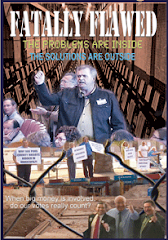PRWatch.org
January 27, 2010 - 9:36pm.
As I watch the response to the State of the Union address, I cannot help but notice that the new
 governor of Virginia, Bob McDonnell, has continued the George W. Bush PR stagecraft in setting the scene for his remarks. Like tokens, he has four supporters strategically positioned behind him to fit in the television screen: an African American woman, a white male soldier, an Asian man, and a young woman.
governor of Virginia, Bob McDonnell, has continued the George W. Bush PR stagecraft in setting the scene for his remarks. Like tokens, he has four supporters strategically positioned behind him to fit in the television screen: an African American woman, a white male soldier, an Asian man, and a young woman.And, "of course," the Virginia statehouse is packed with supporters who applaud at his every applause line, almost on cue.
I've seen this before. In speech after speech, President George W. Bush's handlers ensured that he spoke primarily to friendly cheering audiences, with people standing behind him. Get it, standing behind him. It's great stagecraft. But, it's stagecraft just the same. And, while both parties do it from time to time for events, it seems misleading in some instances and unfitting for the State of the Union address. It's not that there is not racial or gender diversity within the ranks of both parties. There is, although not to the same degree. Of course, it was plain from the film of the actual Members of Congress in the Capitol that the elected quarters of the respondents are largely older white guys. Not that I have anything against older white guys--my dad was one of them. It's just that the diversity behind McDonnell isn't actually representative of the party.
But, I guess what really bothers me is how misleading this "human wallpaper" is. The most egregious example, leaving aside actual campaign appearances versus governing situations, was during Hurricane Katrina. You probably recall that after the disaster struck Americans from all over the country volunteered to help, driving and flying in from every state. At one point, President George W. Bush and his stage-crafters from FEMA (the Federal Emergency Management Agency) stop 50 firefighters from traveling to New Orleans to help people in need so they could appear in his photo op. (The story was first reported in the Salt Lake Tribune, which noted: "As specific orders began arriving to the firefighters in Atlanta, a team of 50 Monday morning quickly was ushered onto a flight headed for Louisiana. The crew's first assignment: to stand beside President Bush as he tours devastated areas.") I remember my shock and anger that he would use these first responders as props when they were urgently needed to help save people from drowning or dying in the aftermath of the levees breaking.
And, while it's not the same, tonight's response brought back those memories: The memory of image versus substance. The idea that reality can be papered over with photos that distort the truth on the ground. The notion that firefighters or minorities or insert your target audience here are just props for politicians. The fact that such imagery works because a picture is worth a thousand words.
In some ways it's a small thing compared to the challenges our country faces. But, in some ways it's representative of a bigger thing. It's a kind of lie. And, it's certainly a propaganda technique.
It's true that presidents of both parties have traditionally given their remarks with the leaders of the Senate and House seated behind them. And, sometimes that has meant applause from behind and at other times it has meant cold silence, depending on which party had a majority in each house of Congress. I'm not lamenting that President Obama could not choose who sat behind him at his annual address. I would lament it if this solemn occasion required by the Constitution were turned into just another campaign event through such machinations.
And, while there is no constitutional requirement of a response from the political minority, it has become a modern TV news tradition. But, now the minority has chosen to make it into just another campaign event, complete with human wallpaper. And, that deserves to be called out.
Lisa Graves is the Executive Director of the Center for Media and Democracy based in Madison, Wisconsin.
















